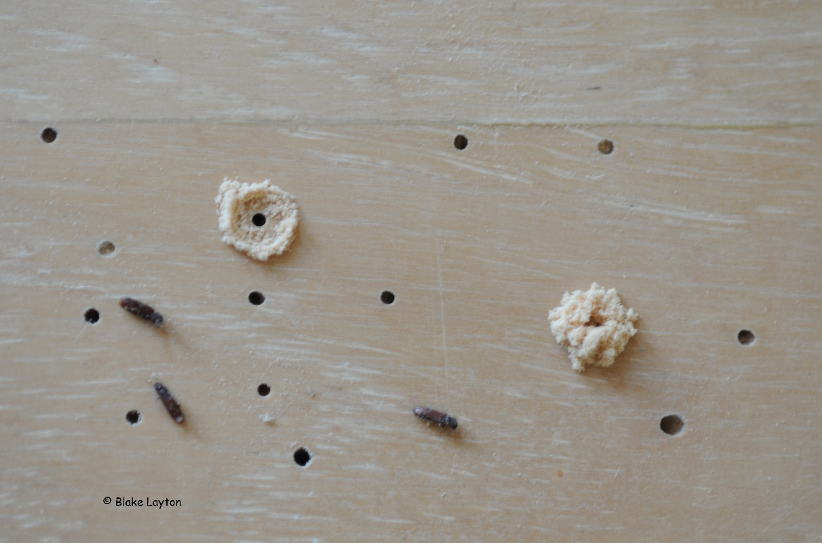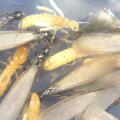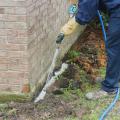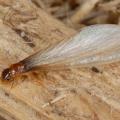Powderpost Beetles in Hardwood Floors

Homeowners who have just spent large amounts of money on new hardwood flooring are understandably dismayed when they notice tiny holes surrounded by piles of fine sawdust in those floors. Their concerns are usually multi-fold: where did these things come from, will they continue to damage the floor, will they spread to other wood in the house, and what should be done about them? Knowing a little about the types of beetles involved, as well as their behavior and biology can help answer these questions.
If they are in hardwood floors, these are most likely lyctus beetles, aka. true powderpost beetles (Family Bostrichidae, sub-Family Lyctinae), especially if the emergence holes are about 1/16th inch in diameter and are surrounded by very fine, flour-like frass. Lyctus beetles occur only in hardwoods, especially species such as pecan, hickory, ash and oaks—where they feed only on sapwood. Females lay their eggs in the relatively large pores these hardwoods contain. Bamboo, which has similar pores, is also attacked. There are several species, but the southern lyctus beetle, Lyctus planicollis, and the brown lyctus beetle, Lyctus brunneus, are the two species most commonly encountered in the state. Although emergence can occur year-round in heated buildings, heaviest emergence, and most complaints, usually occur in spring to early summer.
Unlike termites, lyctus beetle larvae can’t digest cellulose; they live on starch and other nutrients in the sapwood, but starch content declines as wood ages. Consequently, most heavy lyctus infestations occur in wood less than ten years old, and attacks are concentrated in the sapwood. Moisture content also affects susceptibility. Wood with a moisture content below 8 to 10% is not very susceptible, whereas moisture contents in the range of 10 to 20% are ideal for the beetles, and heavy, damaging infestations are usually associated with high moisture content.
Where do they come from?
Although lyctus beetles sometimes occur in wooded areas, where they feed on exposed wood in dead trees and fallen limbs, they are not particularly common in such areas. They are more common around homes and businesses where they reproduce in suitable exposed woods. Wood that will be used for flooring is usually kiln-dried during the early stages of the production process, and this will kill any insects or eggs that have accumulated in the wood up to that point. However, infestations can occur any time after the wood is removed from the kiln and before the flooring is installed and sealed. This could occur while exposed wood or finished flooring is stacked on site at the production facility, while the wood is in transit or in storage at retailers, or at any time when the wood is being delivered and installed, and until the flooring is finished with some type of sealing agent. Lyctus beetles cannot lay eggs in wood that has been sealed with varnish, wax or similar sealants, except that females can use their long, thin ovipositor to insert eggs into old emergence holes or any cracks in the finished surface that provide access to unfinished wood, and, of course, females can continue to lay eggs in any unfinished wood surfaces to which they have access.
How much damage will they cause?
Damage is caused by the larvae feeding and tunneling inside infested wood and heavily damaged wood is structurally weakened. Infestations can range from minor to very severe. It is not uncommon for owners of new hardwood floors, made of pecan, ash or other susceptible woods, to notice a few dozen emergence holes during the first few years following installation. In fact, if you choose a floor made from one of these susceptible woods, you should be prepared to see this type of minor damage. The next step up the damage scale is when individual boards are moderately infested, resulting in dozens of emergence holes in the sapwood of a single board. Such damage may be limited to just a few boards, or there may be dozens of affected boards, and these are usually scattered randomly within the floor. Worst-case infestations usually occur when there is some type of moisture problem that causes the floor to remain unusually moist, allowing high survival and re-infestation. This can result in boards with hundreds of emergence holes and boards that are so severely damaged that they will not support the weight of a chair leg.
Will they continue to damage the floor?
The most honest answer here is “Yes, but probably for only a few more years.” Once flooring is installed and finished, it is much more difficult for beetles to re-infest, but because these beetles can take from one to four years or so to complete a life cycle, new emergence holes may continue to appear for several more years. But, if the floor is kept properly sealed and moisture content is kept low enough, the number of new emergence holes should decline each year. Sealing emergence holes as soon as they are noticed will prevent females from being able to lay eggs back into old emergence holes. Of course, if the floor is installed in such a way that emerging beetles have ready access to unfinished surfaces, re-infestation can continue for many years. Keep in mind that wood becomes less suitable for the beetles as it ages and as moisture content drops.
Will they spread to other wood in the house?
Because lyctus beetles do not attack soft woods, such as pine and spruce; are unable to lay eggs in finished wood surfaces; and do not survive well in older hardwoods, they are not likely to cause serious, building-wide infestations. However, any relatively new, unfinished wood of the types of hardwoods mentioned above would be susceptible to attack. This would include hardwood used as part of the structure of the building, as well as hardwood furniture, paneling or cabinets, especially if these have exposed, unfinished surfaces.
What should be done about them?
In many cases, the do-nothing approach is often the best approach to dealing with light infestations of powderpost beetles in hardwood floors. Such infestations usually dwindle away over time and the tiny emergence holes are often not very noticeable—especially once they are patched with a filler that matches the wood and sealed. Once they understand the situation, many homeowners are more willing to try this approach than to undergo the expense and disruption associated with having the floor removed and replaced or stripped and treated. After all, they can always choose an alternate course later if the infestation continues to grow. But there are some things that can and should be done as part of this “do-nothing” approach. This includes getting and keeping the moisture content low, and keeping the floor surface properly sealed, including promptly sealing any new emergence holes to prevent re-infestation.
The next step up the response ladder is to just replace any individual boards that are heavily infested. Sometimes there are a few boards scattered throughout the floor that have such infestations and an experienced floor installer can replace these quickly. Of course, the floor will have to be refinished once the damaged boards are replaced. Usually these are boards that contain large portions of sapwood, and they were likely on the outside of the lumber stack or flooring bundle, where they would have been exposed to egg-laying females, when the initial infestation occurred.
Some situations require a more aggressive approach, such as stripping the entire floor to remove the finish, replacing all damaged boards, having the floor professionally treated with BoraCare and then refinishing. BoraCare is a borate-based insecticide treatment that can be used to control insects, such as powderpost beetle larvae, that are feeding inside wood. It is applied to unfinished wood surfaces and gradually moves into the wood to provide control and long-term protection.
Having the building tented and professionally fumigated is the most aggressive response and usually the costliest method of dealing with unusually heavy infestations of powderpost beetles. This is the treatment of last resort and for infestations that are limited to floors, many homeowners are likely to opt for one of the other treatment options. Floors that have enough powderpost beetle damage to justify fumigation usually have enough damage that some boards are going to have to be replaced anyway, which often requires stripping and refinishing the floor, which provides an opportunity to apply a borate treatment. However, fumigation may be the only practical method of treating furniture or buildings that have structural infestations of drywood termites or wood-boring beetles.
Of course, powderpost beetles can also occur in situations other than hardwood flooring, and there are many other types of wood-boring beetles that occur in buildings, including the false powder post beetles (family Anobiidae), which are often found in older lumber, both softwood and hardwood. Such infestations sometimes occur in antique furniture and structural wood, such as floor joists and exposed wooden beams in crawl spaces. Time and space do not permit discussing these now, but it is important to keep these possibilities in mind when dealing with an infestation of wood-boring beetles.
Publications
News
Mississippi’s native subterranean termites have started swarming, and these structure-destroying insects will continue to swarm across the state over the next few months.
John Riggins, professor of forest entomology in the Mississippi State University Department of Agricultural Science and Plant Protection, said termites swarm to produce new colonies when the weather warms up, often after a rain.
Termites exist all over Mississippi and will eventually infest and damage any structure that contains wood or other cellulose components unless you properly protect those structures.
Invasive Formosan subterranean termites were first found in the state 40 years ago, and soon, these dangerous pests will swarm and threaten unprotected structures in about one-third of Mississippi’s counties.
Santos Portugal, Mississippi State University Extension Service urban entomologist, said Formosan termites typically swarm in the millions from early May to early June. They have the ability to infest and significantly damage structures much more quickly than native subterranean termites.
Success Stories
A dream of the Mississippi Pest Control Association and the Mississippi State University Extension Service is coming true after more than 20 years, thanks to a generous donation by one of Mississippi’s oldest pest-control companies.







